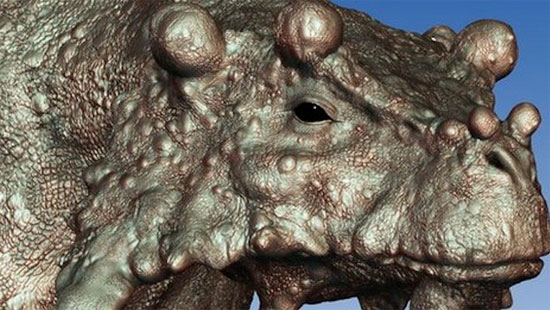Detecting ugly reptile fossils, head full of humps
Archaeologists have found fossils a strange reptile with many small bumps on its head, isolated on the vast desert in Africa 260 million years ago.
The fossil of this strange reptile is found in northern Niger, Africa, belonging to a new genus of pareiasaur , a fairly common plant group in the Permian period.

Scientists recreate Bunostegosimage- (Photo: BBC News)
Described in the Journal of Vertebrate Paleontology , this special creature is about the size of a cow, named Bunostegos , which means ' humpy roof'.
Archaeologists say that in the Permian period, the Earth had only one super continent called Pangea . Animals and plants are widely distributed throughout the continent. However, with new research conducted by an international team, there was a desert between Pangea and special animals.
Most pareiasaurs have osteosarcoma on the head, but in Bunostegos there are the largest humps. In addition, Dr. Linda Tsuji from the University of Washington, Seattle told BBC News that most of the osteosarcoma on the heads of both seemed to have no protective function.
Through studies and evidence found, scientists believe that the genealogical lineage of the Bunostegos creature was isolated, isolated in the arid desert for millions of years. Long periods of isolation in arid conditions have made Bunostegos Develop its unique anatomical features.
Fossil studies from around the world, such as Bunostegos fossil fossils in North Niger have contributed to a more comprehensive picture of ecosystems during the Permian period.
- Find new flying reptile fossils
- Unexpected fossil detection of marine reptiles has 4 nostrils
- Rare discovery of fossils in fossils
- Found fossils of marine reptiles carrying embryos
- Detecting fossils of the snakehead dragon
- Big ocean killer with bus living with dinosaurs
- The world's worst-known creature before dinosaurs
- British people rushed to hunt for ancient treasures on the coast
- Discover 200 million year old fossil with a belly filled with squid
- Discovered new species of non-foot reptile
- Prehistoric geese are called Lenin
- Reptiles in danger of extinction
 Discovered an ancient centipede fossil 99 million years old
Discovered an ancient centipede fossil 99 million years old Discovered bat-like dinosaurs in China
Discovered bat-like dinosaurs in China Discovered a 200-year-old bronze cannon of the coast
Discovered a 200-year-old bronze cannon of the coast Discover 305 million-year-old spider fossils
Discover 305 million-year-old spider fossils